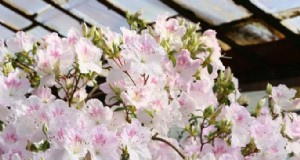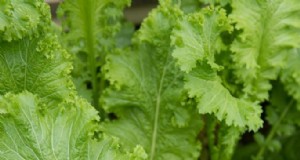Hoya spp.
Você seria perdoado por ignorar hoyas à primeira vista. Sua beleza pode ser um pouco subestimada. Mas uma vez que essas plantas de casa chamam a sua atenção, cuidado - você pode cair em uma toca de coelho hoya muito profunda.
Uma das coisas que torna essas lindas plantas de casa trepadeiras e rastejantes tão intrigantes é sua vasta gama de cores de folhas, formas, e texturas.
E como se a folhagem fascinante já não bastasse, hoyas podem produzir flores marcantes e perfumadas o suficiente para competir com algumas das plantas ornamentais mais vistosas, no entanto, você pode cultivá-los dentro de casa!
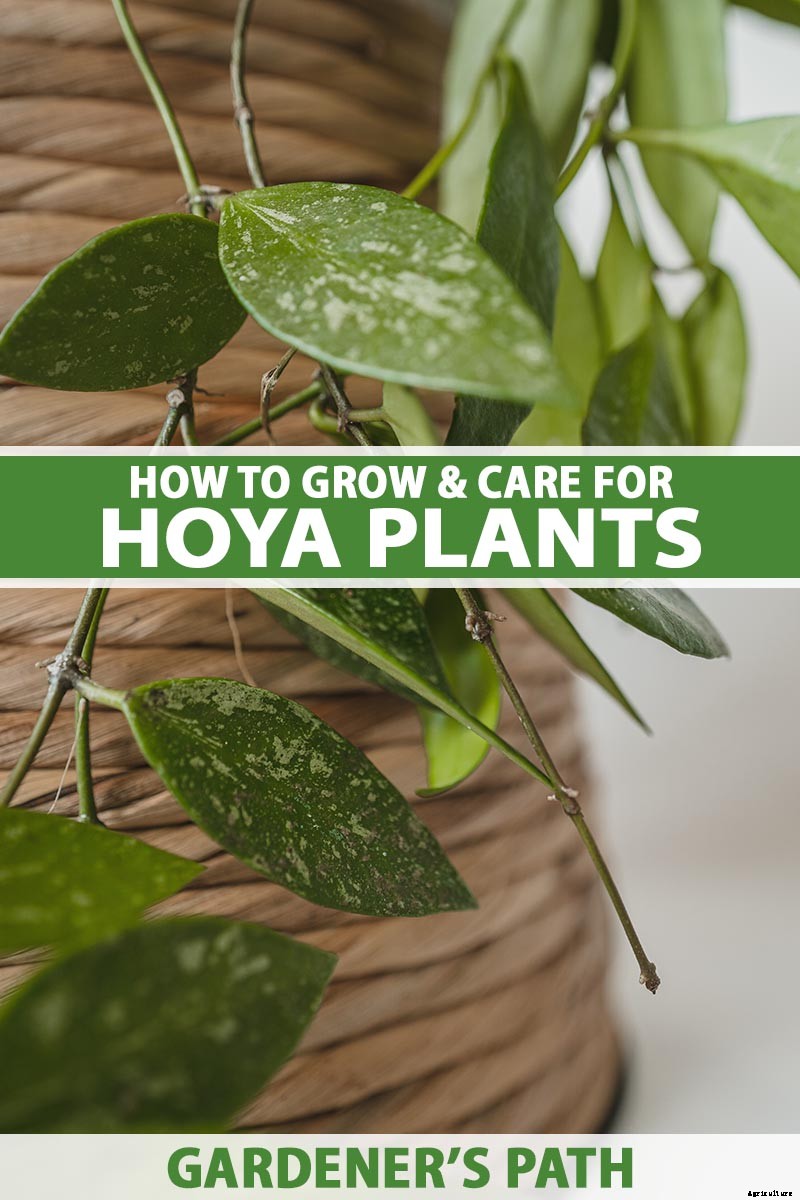
Você pode imaginar que uma planta de casa tão linda exigiria uma manutenção muito elevada. Não tão! Pelo contrário, hoyas provavelmente precisa de um pouco menos de atenção do que a média.
Você está pronto para cair em uma toca de coelho hoya com a gente? Prepara-te, porque você pode nunca mais ser o mesmo. Aqui está o que vamos cobrir:
Cultivo e História
Hoya é um gênero que compreende vinhas e arbustos nativos da Ásia tropical e subtropical e da Oceania.
O gênero inclui pelo menos dois ou trezentas espécies diferentes , embora isso possa ser uma subestimativa, pois há novas espécies sendo descobertas e descritas regularmente.
A maioria dessas espécies são epífitas - em seus habitats nativos, suas raízes não crescem no solo, mas nas fendas das árvores.
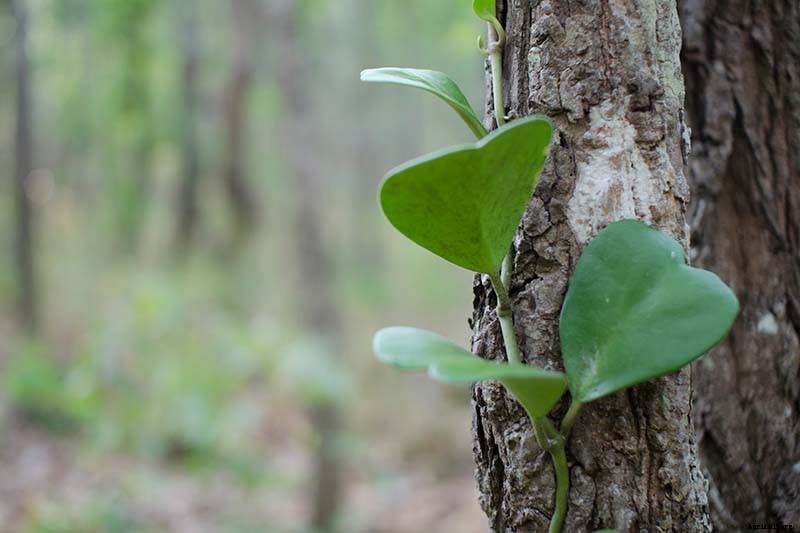
A maioria dos hoyas disponíveis para cultivo dentro de casa tem o hábito de crescimento de vinha e arrasto.
Com folhagem perene, os numerosos Hoya espécies disponíveis como plantas de interior oferecem uma grande variedade de opções na cor das folhas, Tamanho, forma, e textura.
Alguns têm folhas verdes brilhantes, outros exibem uma bela variação, e alguns têm folhas enrugadas.
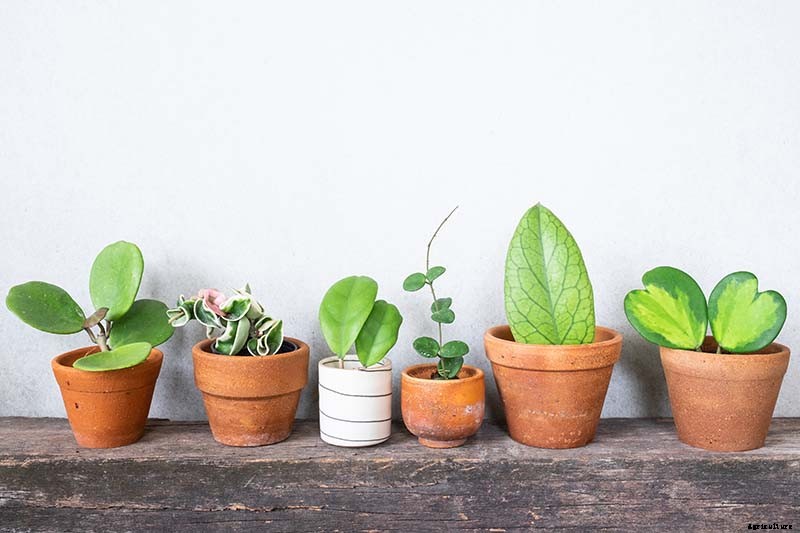
As folhas dessas plantas tendem a ser grossas e suculentas, tornando-os capazes de armazenar água por longos períodos de tempo. Contudo, a folhagem de algumas espécies é mais fina, tornando essas plantas menos tolerantes à seca.
Uma coisa que muitas vezes confunde os novos pais de plantas de soja é o comprimento, vinhas nuas dessas plantas, às vezes chamados de “chicotes”.
Espécies Vining Hoya produzem esses chicotes, que são projetados para buscar árvores como suporte, para que eles possam crescer mais alto no dossel da floresta.
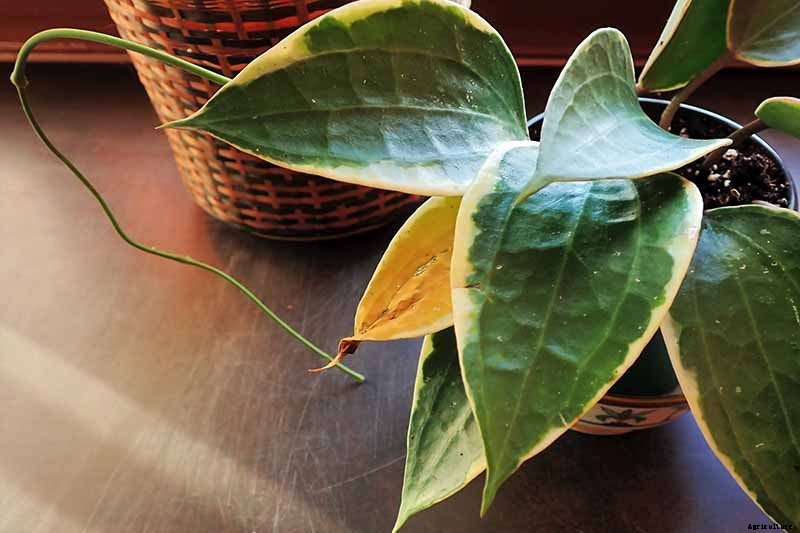
Essas gavinhas nuas acabarão criando raízes aéreas e folhas.
As flores de Hoya são geralmente perfumadas e vistosas, e vêm em uma grande variedade de cores dependendo da espécie ou cultivar.
Os cachos de flores são geralmente arredondados, pequeno a grande em tamanho, e exibem flores individuais que são em forma de estrela e tendem a ter centros contrastantes.
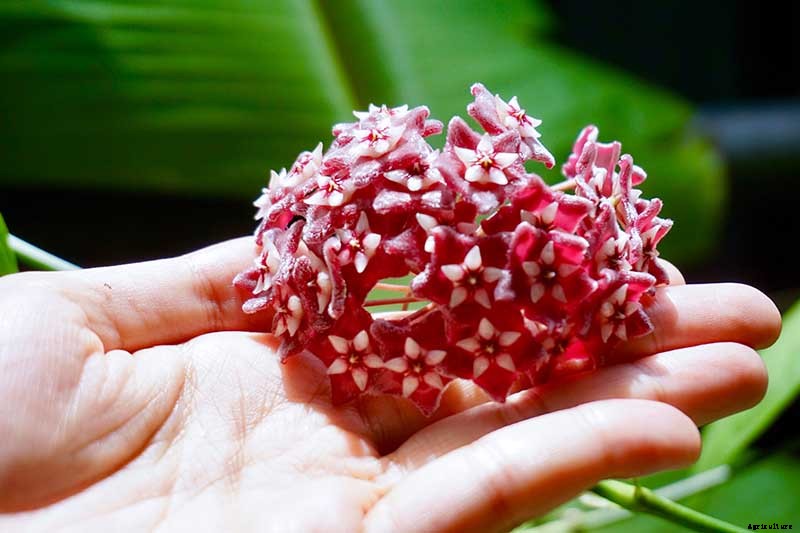
Uma vez que muitos membros deste gênero são polinizados na natureza por mariposas, suas flores tendem a ser mais perfumadas à noite do que durante o dia.
Se as flores desta planta de casa parecem familiares, você pode estar notando sua semelhança com as flores que atraem borboletas monarcas da flor silvestre nativa da América do Norte, serralha .
Hoyas e milkweeds são membros da mesma família, Apocynaceae, também conhecida como família dogbane.
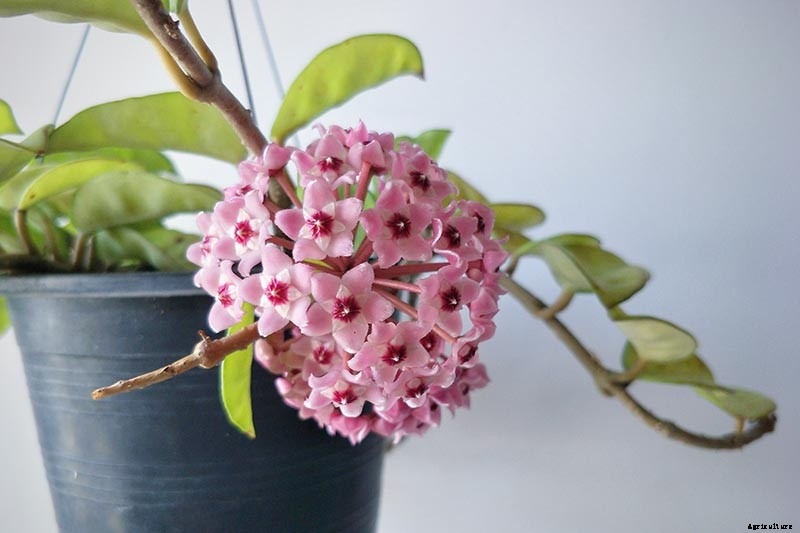
Além de ser usado como nome comum, como acima mencionado, Hoya também é o nome do gênero no qual essas plantas são classificadas para fins científicos.
Este gênero era nomeado pelo botânico escocês Robert Brown em homenagem a seu amigo e colega botânico, Thomas Hoy. Brown foi o primeiro a descrever o gênero na literatura científica.
Além do nome “hoya, ”Os membros deste gênero também são conhecidos como“ flores de porcelana, ”“ Plantas de mel, ”E“ plantas de cera ”.
Alguns dizem que são comumente chamados de "plantas de cera" por causa de sua espessura, folhas suculentas, enquanto outros afirmam que o nome é inspirado por suas flores e botões de flores de aparência cerosa.
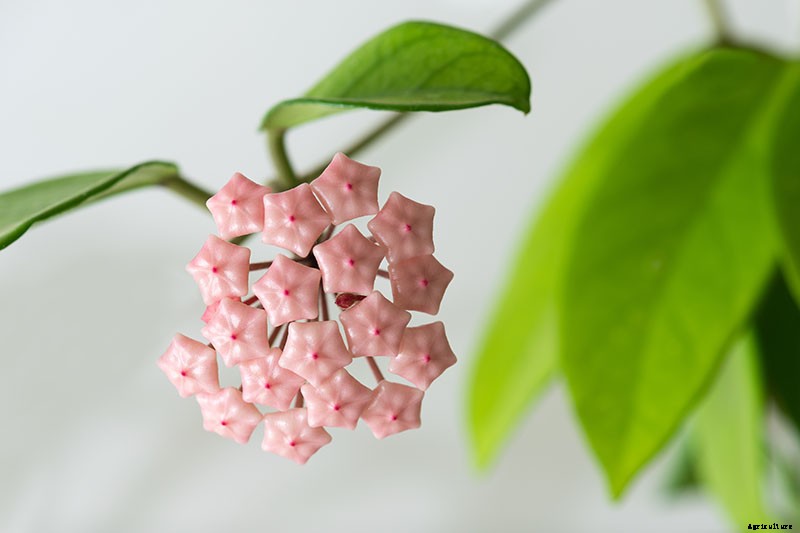
Embora essas espécies sejam amplamente utilizadas como plantas domésticas, alguns deles também têm uma história de uso etnobotânico em seus habitats nativos.
Uma nota de cuidado:
Muitos hoyas liberam uma seiva branca de folhas e caules quebrados que pode ser irritante para algumas pessoas. Indivíduos sensíveis devem ter cuidado e podem querer manusear hoyas com luvas de jardinagem.
E embora muitas espécies de hoya sejam consideradas não tóxicas para animais de estimação, nem todas as espécies que podem ser usadas como planta de casa foram confirmadas como não tóxicas.
Portanto, seja cauteloso com essas plantas e mantenha-as fora do alcance de crianças e animais de estimação curiosos. Você não quer que sua coleção hoya seja mastigada de qualquer maneira, você?
Propagação
Hoyas pode ser propagado a partir de sementes, estacas de folhas, e estacas de caule, ou por camadas.
Contudo, as sementes de algumas dessas plantas só são viáveis por alguns dias, tornando a propagação de sementes complicada. E quando se trata de enraizar folhas, a maioria dos jardineiros não consegue produzir uma nova planta dessa maneira.
Os métodos mais fáceis para propagar hoyas com sucesso são enraizando as estacas do caule ou em camadas, e vamos cobrir ambos aqui.
O processo para qualquer um desses será mais fácil ao começar com uma planta madura com videiras longas.
De cortes de caule
Muito parecido com tomates , hoyas crescem raízes adventícias de seus caules, tornando mais fácil propagá-los a partir de estacas.
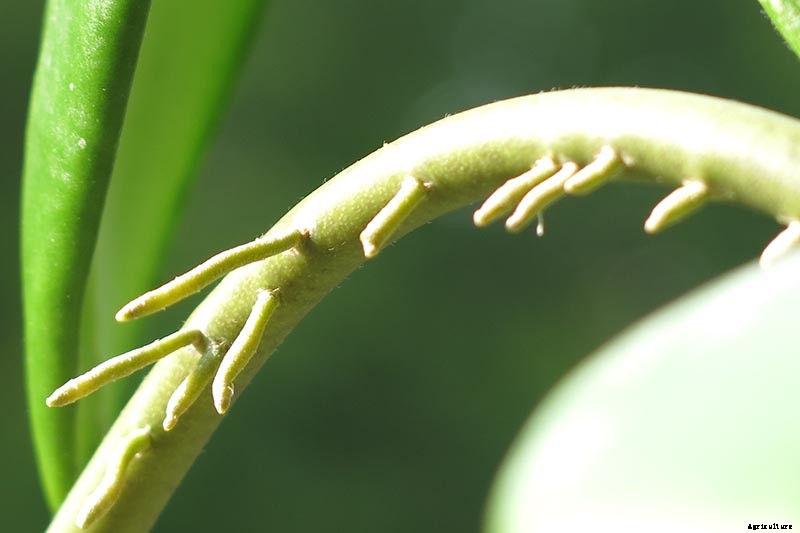
As estacas enraizarão mais rapidamente durante as estações quentes, quando sua planta de casa está em um período ativo de crescimento - no entanto, isso não significa que você não pode dar uma chance a este projeto divertido durante outras épocas do ano!
Ao tomar o seu corte, use uma tesoura esterilizada ou um recorte de jardim para evitar a propagação de doenças.
Também, certifique-se de incluir pelo menos um a dois nós.
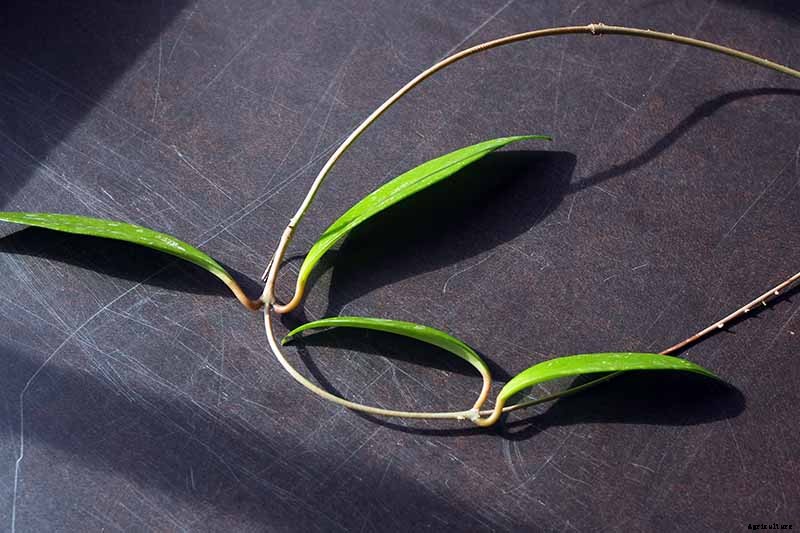
Deixe um pouco do caule abaixo dos nós do fundo para ajudar a ancorar sua estaca no meio de envasamento.
Remova as folhas do nó inferior - é aqui que, idealmente, as raízes da sua nova planta crescerão.
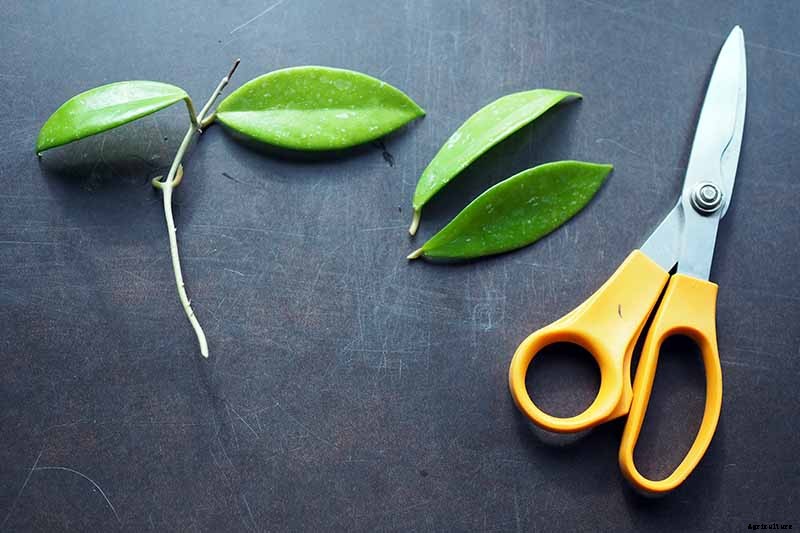
Depois de tomar seu corte, você pode usar gel ou pó de hormônio de enraizamento.
Embora muitos jardineiros sejam capazes de enraizar essas plantas sem ele, se você é do tipo impaciente, o hormônio do enraizamento encoraja as raízes a crescerem mais rapidamente.
Se você decidir usar este tipo de produto, Eu recomendo Olivia’s Cloning Gel, disponível para compra na Arbico Organics em dois-, quatro-, e recipientes de oito onças.
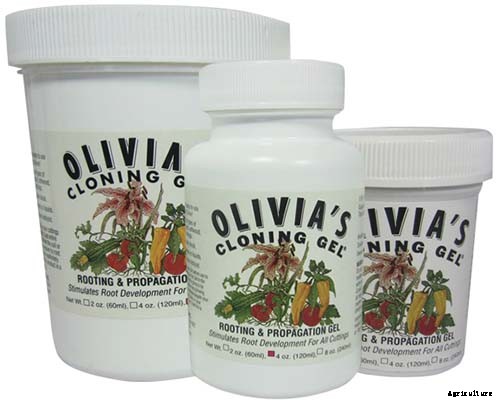
Gel de Clonagem de Olivia
Depois de ter suas mudas, você também pode enraizá-los em uma jarra de água e pular o gel de hormônio.
Mas alguns jardineiros descobrem que mudas enraizadas em um meio de cultivo tendem a fazer a transição para a vida em vaso com mais facilidade do que aquelas iniciadas na água.
O musgo sphagnum é o meio de enraizamento normalmente usado para esta finalidade, no entanto coco coir é uma boa alternativa .
Eu prefiro Prococo Compressed Chips-N-Fiber, que é uma mistura de cascas de coco em pedaços e fibra de coco fina.
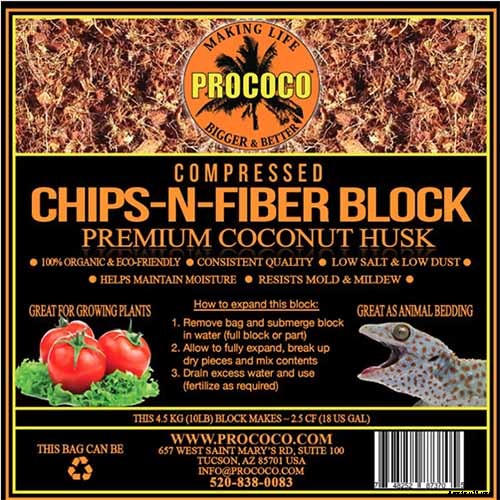
Prococo Compressed Chips-N-Fiber
Seu disponível para compra na Arbico Organics em blocos de 10 libras.
Encha um pequeno frasco com meio de cultura umedecido e coloque sua estaca de modo que o o nó inferior está na superfície do solo . Isso irá estimular o crescimento da raiz e a formação de novos botões.
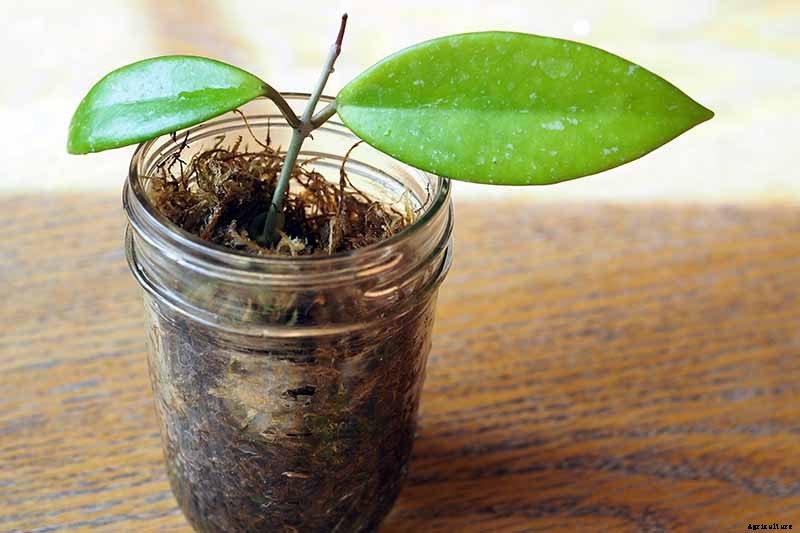
Enquanto sua estaca cria raízes, não deixe o meio de enraizamento secar - mantenha-o úmido, mas não encharcado.
As raízes devem começar a crescer dentro de três a quatro semanas, e novos botões crescerão em cerca de outras três semanas depois disso.
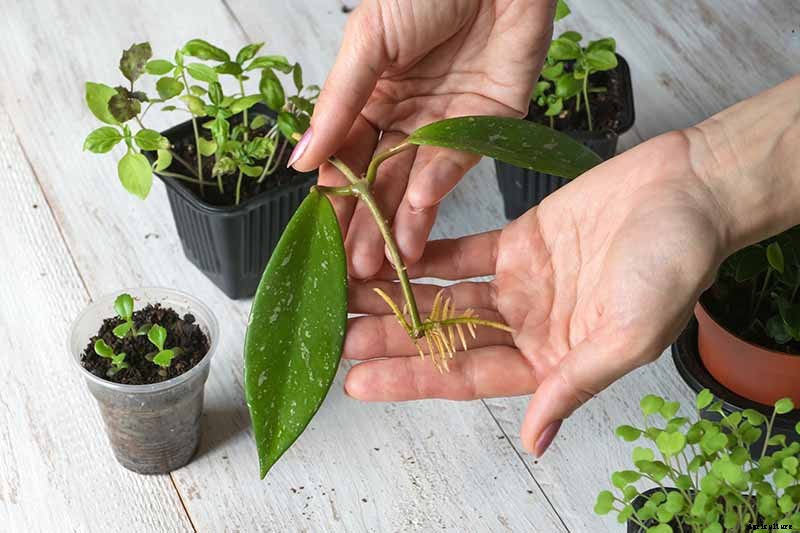
Quando as raízes da estaca do caule têm uma ou duas polegadas de comprimento, está pronto para empacotar.
Ao envasar suas mudas enraizadas, comece com uma panela pequena de 5 a 10 cm. Você encontrará dicas adicionais para envasar hoyas um pouco mais adiante neste artigo.
Após o envasamento, mantenha o solo úmido enquanto a planta se ajusta à sua nova casa, diminuindo gradualmente a irrigação até que sua planta propagada seja irrigada na mesma frequência que sua planta-mãe.
Por Camadas
A estratificação costuma ser um método ainda mais fácil de propagação do que tirar estacas.
Com camadas, você coloca uma videira em outro pote de mistura para envasamento umedecido enquanto ainda está preso à planta-mãe, permitindo que a videira crie raízes na mistura.
Use um pequeno, panela de duas ou dez polegadas com orifícios de drenagem. Você aprenderá sobre as recomendações do meio de envasamento em breve, então continue lendo!
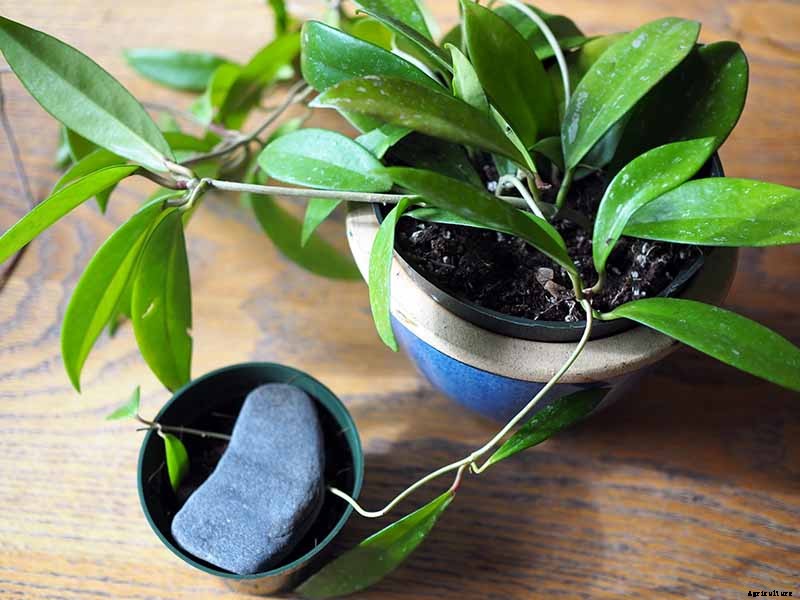
Você pode pesar a videira com uma pequena pedra, ou você pode usar alfinetes florais para segurar o caule enquanto as raízes se firmam. Você encontrará alfinetes florais disponíveis para compra em a Hotop Store via Amazon .
Regue o meio de envasamento do seu bebê hoya sempre que você regar a planta-mãe.
Uma vez que o caule em camadas produz raízes e está crescendo com segurança no solo, você pode cortar o caule conectando-o à planta-mãe - com uma tesoura limpa, claro.
A vantagem deste método sobre o método de corte do caule é que você não precisa se preocupar com o choque do transplante.
Como crescer
Existem muitos tipos diferentes de hoyas, portanto, certifique-se de verificar as condições de cultivo exigidas para sua espécie em particular. Seguindo, você encontrará dicas gerais de cuidados de cultivo para essas plantas.
Escolhendo uma planta
Comece certificando-se de escolher uma espécie ou cultivar que se adapte bem às suas condições de cultivo. Você aprenderá mais sobre os diferentes tipos de hoyas um pouco mais adiante neste artigo.
Próximo, escolha um espécime saudável. Procure um que pareça bem cuidado, sem folhas amareladas ou escurecidas ou sinais de infestação de insetos. Você aprenderá como detectar pragas nessas plantas um pouco mais tarde também.
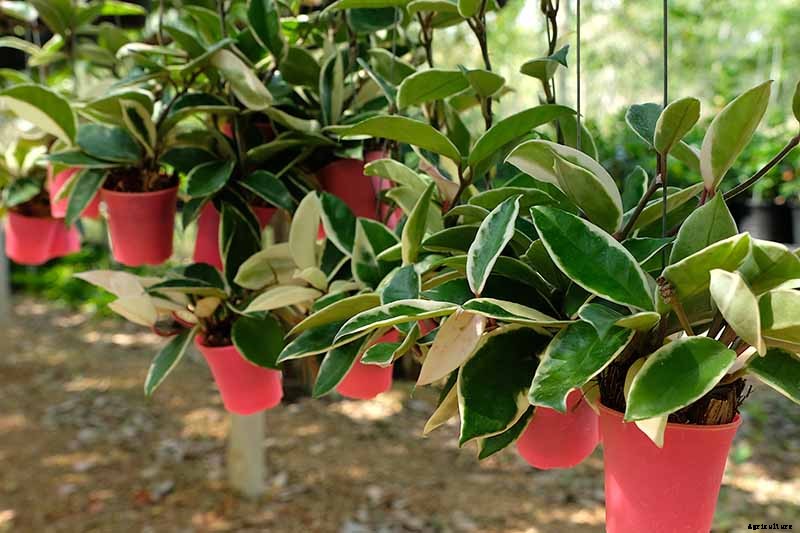
Se você comprou sua planta de casa de um vendedor online, uma vez que você desempacotou e fez uma pequena dança feliz, inspecione-o para ver se há folhas danificadas e insetos.
Eu recomendo fortemente que você coloque em quarentena longe de qualquer outra planta doméstica por alguns dias, enquanto mantém um olho aberto para pragas que podem ter pegado uma carona.
E embora seu primeiro pensamento seja dar uma bebida à sua nova soja assim que ela chegar, você pode não querer fazer isso com esta planta de casa, a menos que pareça muito seca. Você aprenderá mais sobre como regar essas plantas domésticas em breve.
Luz
Na natureza, a maioria dos hoyas cresce em luz salpicada. Traduzir isso para as condições internas significa que a luz indireta brilhante tende a funcionar melhor.
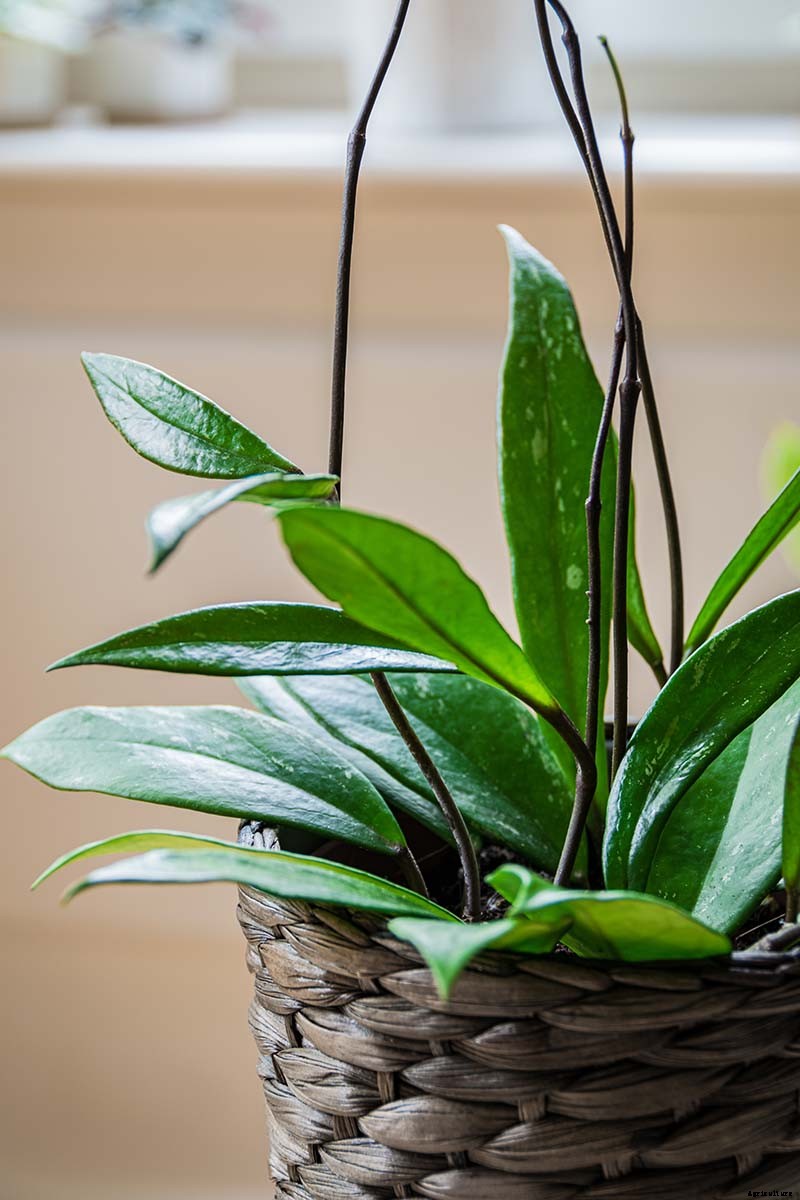
Hoyas também pode crescer em luz indireta média, mas a maioria não florescer nessas condições. Também, se os níveis de luz estiverem muito baixos, hoyas variegados podem perder sua variegação.
Se as condições internas não forem claras o suficiente, você pode querer investigar as opções de iluminação artificial. Aprender sobre usando luzes de crescimento em nosso artigo .
Um pouco de sol direto pela manhã é bom para a maioria das espécies, apenas mantenha-o por não mais do que algumas horas.
Para espécies que apresentam uma bela coloração quando estão estressadas com o sol, certifique-se de que as folhas da sua planta não estejam escaldantes ou queimando - se estiverem, afaste-se um pouco da exposição ao sol.
Temperatura
Uma vez que hoyas são espécies tropicais e subtropicais, eles se dão bem nas temperaturas normalmente encontradas em nossas casas com aquecimento e ar-condicionado, em torno de 70 ° F.
A exposição a baixas temperaturas pode fazer com que as folhas fiquem amarelas. Estas plantas domésticas não são resistentes ao frio e podem ser danificadas por temperaturas muito acima de zero, portanto, certifique-se de sempre mantê-los acima de 45 ° F.
Outra forma de manter essas plantas domésticas felizes é evitar correntes de ar frio e pontos quentes.
Isso significa que você deve evitar colocá-los muito perto de portas externas, ou muito perto de janelas com correntes de ar.
Também tome cuidado com os locais próximos a lareiras, registros de calor, e radiadores, ou em cima de aparelhos que aquecem, como as tampas de geladeiras.
Depois de identificar um bom local para o seu hoya, tente não movê-lo. Essas plantas realmente não gostam de ser movidas.
Água
Em geral, é um bom hábito deixar a soja secar antes de regá-la.
Alguns produtores de soja permitem que os primeiros centímetros do solo sequem antes de regar, enquanto outros preferem deixar o meio de envasamento da planta secar completamente.
Determinar quanto deve secar depende de muitos fatores, incluindo o tipo de soja que você tem.
Isso pode significar que você só vai regar sua planta a cada duas semanas, ou até com menos frequência - a rapidez com que sua soja seca vai depender de seu solo para envasamento, seu pote, e as condições da sua casa.
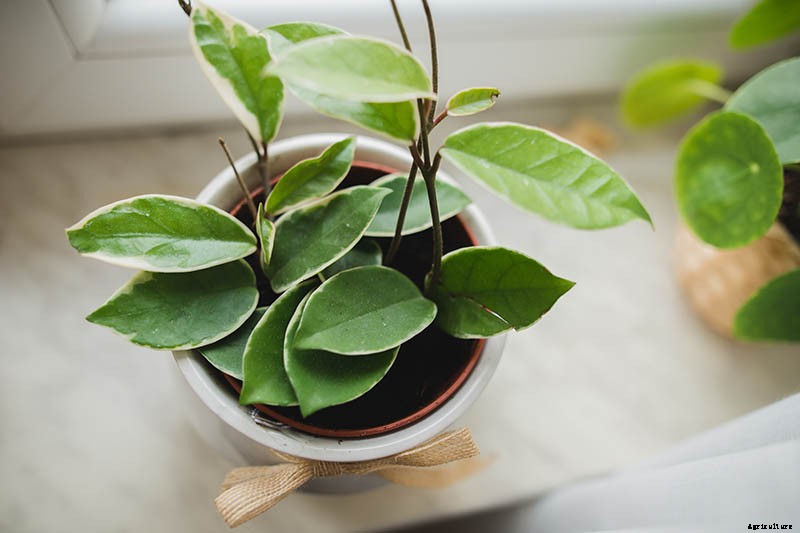
Se sua planta está em uma panela de terracota em oposição a uma de plástico , vai secar mais rapidamente. Sua hoya também precisará de rega mais frequente se for mantida em local mais claro, luz mais direta.
E se as folhas de sua espécie são mais finas e menos suculentas, como com H. retusa ou H. multiflora , isso significa que ele tem menos capacidade de conservar umidade e precisará ser regado com mais frequência.
Qualquer espécie que você tenha, planeje reduzir a frequência de sua programação de irrigação durante o inverno.
Quando você rega, usar água da chuva em temperatura ambiente, água destilada, ou água filtrada.
Como saber se você está regando direito com essas plantas?
Se a folhagem de seu espécime começar a ficar macia em vez de firme, já passou da hora de regar. E se você começar a notar folhas murchas, você esperou muito tempo.
Por outro lado, se as folhas estão ficando amarelas e caindo, você provavelmente está regando demais.
Enquanto você conhece seu hoya, Eu recomendo manter o controle de sua programação de irrigação em um calendário ou em seu jornal de jardinagem , e ajustando conforme necessário.
Uma vez que essas plantas caseiras estão mais maduras, a folhagem no topo pode dificultar ver onde você está regando, então, neste caso, você pode preferir molhar a planta por baixo.
As instruções passo a passo para esta técnica são disponível em nosso artigo sobre irrigação de fundo .
Umidade
Embora os hoyas gostem quando você deixa o solo secar, vindos de climas tropicais e subtropicais como eles fazem, eles também gostam de um pouco de umidade.
Exatamente quanto irá variar de espécie para espécie, uma vez que vêm de diferentes locais nativos.
Manter o ambiente interno umidade de 30 a 40 por cento para seus hoyas é uma boa regra.
Esses níveis não são tão altos quanto os exigidos pelas plantas nervosas, pileas, ou certas orquídeas, mas eles são maiores do que muitos de nós temos em nossas casas, particularmente durante os meses de inverno, quando nossos sistemas de aquecimento secam o ar.
Uma das maneiras mais fáceis de aumentar os níveis de umidade relativa de suas plantas é agrupá-las. Um agrupamento de plantas pode ajudar a aumentar os níveis de umidade ambiente, criando um microclima.
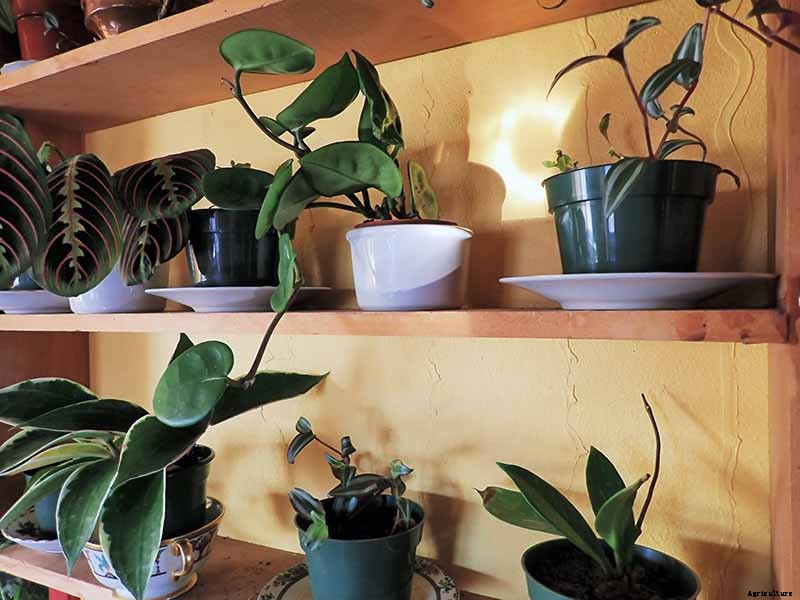
Outra boa medida para aumentar a umidade é colocar uma bandeja de seixos sob as plantas. Você pode fazer o seu próprio - basta encher uma bandeja, placa, ou pires com pedrinhas, em seguida, adicione água.
A panela e seu pires devem ficar em cima das pedras acima da água, para que o solo não absorva a água de baixo.
A água na bandeja irá evaporar lentamente, aumentando o nível de umidade ao redor das plantas.
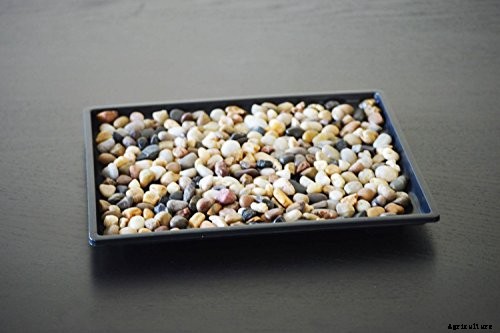
Bandeja de Umidade
Se você não quiser fazer sua própria bandeja de seixos, você pode comprar um. Você encontrará uma bandeja de seixos de sete por nove polegadas disponível na 9GreenBox via Amazon .
Solo
A maioria das espécies de soja que são mantidas como plantas domésticas são epífitas. Isso significa que eles não estão acostumados a ter suas raízes mergulhadas em solo fértil. Pelo contrário, Na natureza, suas raízes crescem nas fendas rasas das árvores.
Traduzindo isso em necessidades internas, começar com, essas plantas de interior requerem excelente drenagem e se dão bem com misturas de envasamento grossas que permitem que suas raízes recebam bastante fluxo de ar.
As condições nativas variam de espécie para espécie, mas em geral, hoyas preferem um meio de envasamento com um pH variando de ligeiramente ácido a ligeiramente alcalino, cerca de 6,1 a 7,3.
Se você quiser fazer sua própria mistura de envasamento, uma boa receita básica de solo para hoyas consiste em partes iguais de solo para envasamento, pedra-pomes ou perlite, e casca de orquídea ou cascas de coco.
Embora ambos ajudem na drenagem, Eu recomendo escolher pedra-pomes em vez de perlite. Uma vez que os vasos de soja são geralmente bastante pequenos para a quantidade de folhagem que essas plantas produzem, eles podem tombar facilmente, e a pedra-pomes fornecerá um pouco de peso extra para ajudar a manter o seu vaso estável.
Se você preferir comprar um meio de envasamento pré-misturado em vez de fazer o seu próprio, a Associação Internacional de Hoya recomenda uma mistura de envasamento suculenta.
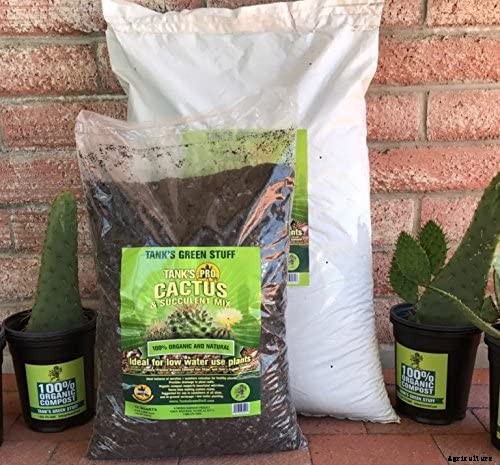
Tank’s Pro Organic Cactus and Succulent Mix
Meu meio de envasamento preferido para hoyas é Tank’s Pro-Organic Cactus and Succulent Mix, que tem a textura robusta e excelente drenagem de que essas plantas precisam para se desenvolver.
Contém cascas de coco, pedra-pomes, e composto orgânico, and is available from Tank’s Green Stuff Store via Amazon .
Growing Tips
- Provide bright, luz indireta.
- Allow at least the top 1-2 inches of soil to dry between waterings.
- Use a chunky potting medium with excellent drainage.
Pruning and Maintenance
Over the long term, hoyas are low-maintenance plants. Contudo, there are some care tips you’ll want to know to allow them to really thrive in your home!
Fertilizante
Na natureza, these plants would be lightly fertilized by decaying organic matter. Since that isn’t on the menu when they grow in our homes, fertilizing will help make up for it.
During the period when the plant is actively growing in spring and summer, you can use a general houseplant fertilizer.
I like Dr Earth’s Pump and Grow liquid houseplant food, available for purchase from the Dr. Earth Store via Amazon .

Dr. Earth Pump and Grow
Be sure to follow the manufacturer’s recommendations for using this product.
Poda
Pruning is certainly not a required task, but if you want to create a bushier-looking plant, this will be a useful tactic.
You can selectively prune vines and then use them to propagate new plants. But you may also want to prune off discolored leaves.
When pruning this houseplant, use sterilized scissors or garden snips. To sterilize them, wipe them with a paper towel dipped in hydrogen peroxide. This will ensure that you don’t spread any lurking diseases to your cherished plants.
To prevent bacterial infection at the site of the cuts, you might employ a natural remedy:try dabbing cut stems with ground cinnamon, qual é naturally antibacterial .
Trellising and Staking
Since these plants produce small aerial roots, one of the fun maintenance perks for hoyas is that you can train their vines to grow on stakes or trellises.
You can even train them to grow up the hangers of their baskets rather than letting their vines cascade down.
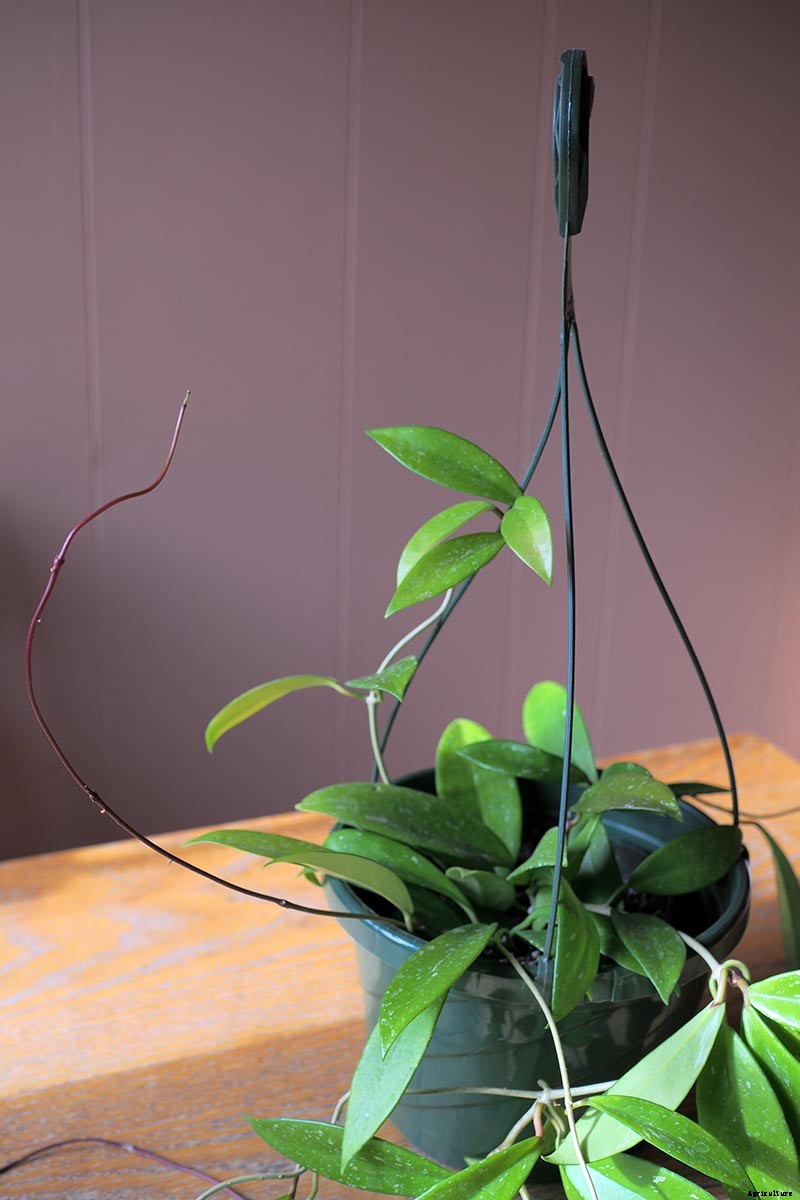
You may want to find out how long the vines of your species can grow before you choose a trellis or stake, as it can be a little tricky to unravel those vines once they’re tangled together, considering that some species’ vines can reach fifteen feet long or more.
And if your species has large leaves, make sure to choose a support that is well proportioned.
Whatever type of support you choose, also make sure it is sturdy enough.
One option is to use a large center pole, such as this Blooming Jungle coco coir-wrapped wooden stake.
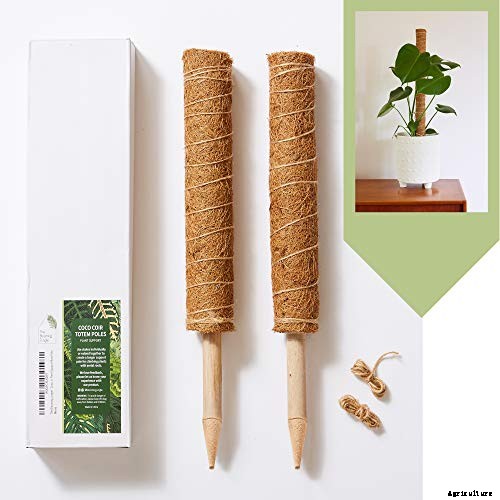
Coco Coir 24” Wrapped Plant Pole
What’s particularly nice about this one is that you can extend the pole at the top when you need to. It’s available for purchase from the Blooming Jungle Store via Amazon .
Another option is to use a trio of slim bamboo stakes. You can space them in a teepee shape around your plant, then attach them at the top with a length of twine.
This type of support will give you a pyramid-shaped mound of foliage.
You’ll find a 12-pack of three-foot bamboo stakes available from the Bond Store via Amazon .
Finalmente, another option for training the vines of your hoya is to use a trellis. Your houseplant can be trained to grow on a circle, spiral, or whatever shape strikes your fancy, and can be wrapped around multiple times to create a thick mass of foliage.
For smaller specimens, you’ll find a copper-colored set of four 11- to 12-inch metal topiary trellises from Amber Oasis, available via Amazon .
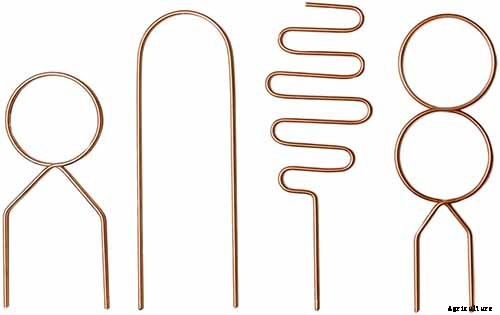
Four Pack Copper-Colored Small Metal Trellises
When you’re ready to stake or trellis your hoya, you can tie the vines loosely to their support with twine, attach them with plant clips, or simply wrap and tuck them under each other.
As the vines grow longer, you can loop them around their trellis or stake multiple times.
Repotting
These species prefer to be rootbound, and don’t always respond well to repotting, so frequent repotting is not recommended. Wait until the plant is quite rootbound before you repot it.
How long this takes will depend on your growing conditions and your selected species. Check your plant’s roots every year or two and see how they look.
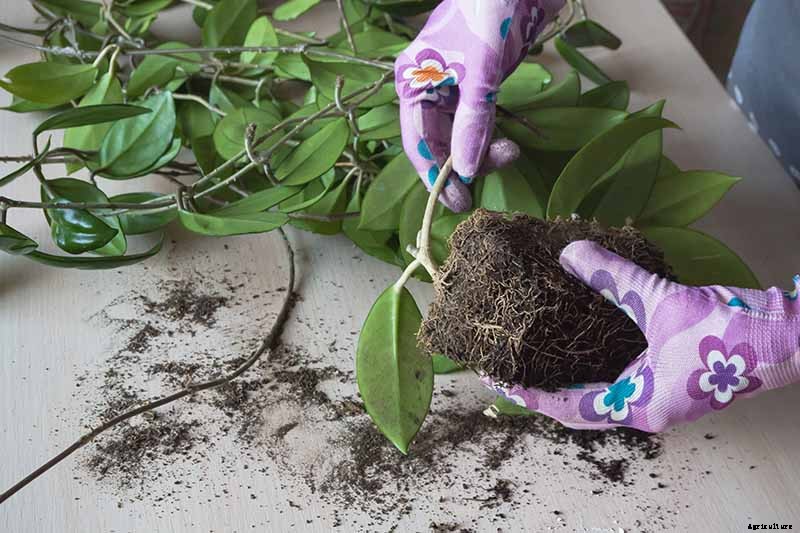
Também, if your houseplant starts to dry out more quickly than usual, that may be a sign that it’s time to repot.
Claro, there’s another reason you may wish to repot your plant – if you welcome home a new hoya that is potted in inadequate potting soil.
Nesse caso, you can simply repot the plant in the same container, changing out the potting medium.
Whatever your motivation for repotting, wait if you can until the plant is in a period of active growth during spring or summer.
When it’s time to repot, choose a suitable container with drainage holes, as well as a suitable potting medium. Be sure to review our recommendations for the potting medium above.
Since most hoya species grow in the wild as epiphytes, they don’t have deep roots – which means they don’t need deep pots.
Choosing a pot on the shallow side that is only one size up from your current container will provide enough room for your houseplant’s roots while helping to prevent waterlogging.
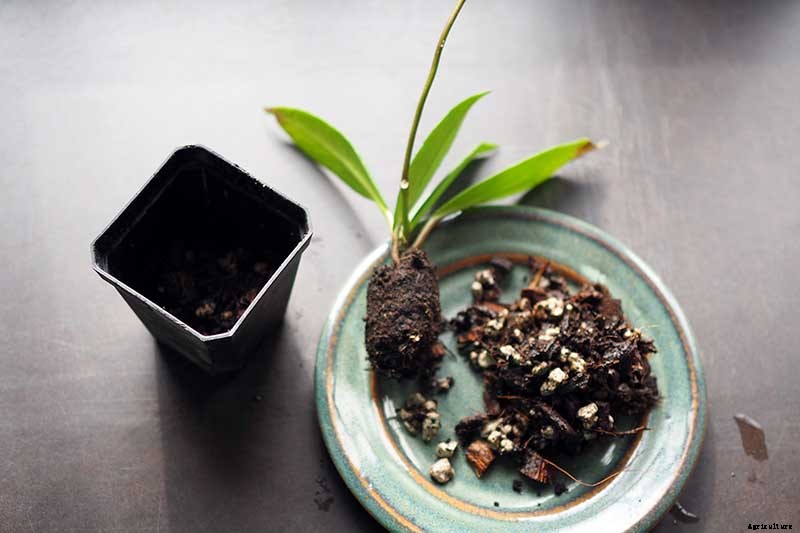
Remove the plant from its pot. If you are changing out the potting mix, gently remove some of the soil from around the roots.
If you are using a large stake, this is the time to position it in your pot. For lighter-weight trellises or stakes, you can position the plant before adding these.
Place some of your new potting mix in the bottom of the pot. If your plant is very rootbound, rub the sides of the roots to help loosen them up a bit, to make it easier for them to adapt to the new potting mix.
Combine just a little of the old soil with the new potting mix. This will help water to transfer between the old soil and the new, and may help to give your plant an easier transition.
Situate the plant into its new pot, making sure to leave half an inch or so between the rim of the container and the surface of the potting medium.
If the soil is too close to the rim, you’ll make a mess when you water, with dirt running out of the pot from the top.
Once your plant is centered and settled, backfill with potting mix.
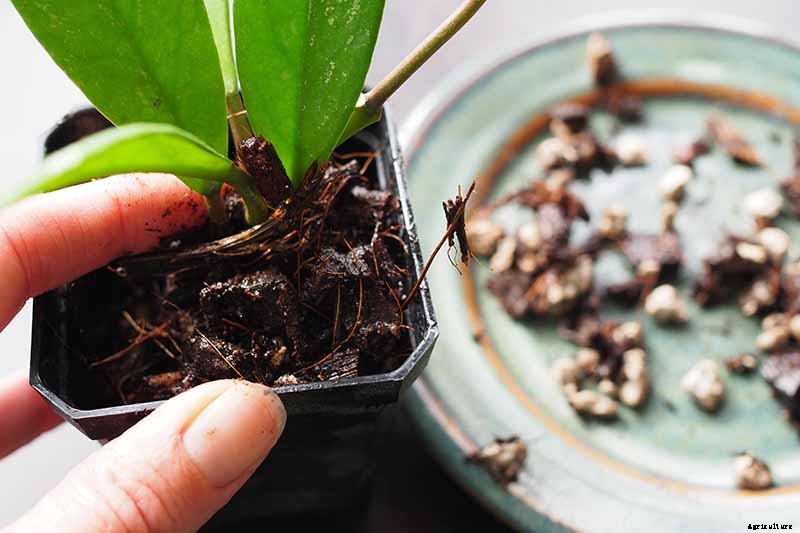
If you’re using a lightweight stake or trellis, put it into position now.
Water in your newly repotted plant and return it to its previous location.
Encouraging Flowering
If you’ve brought a hoya into your home in the hopes of coaxing it to bloom, be aware that these species will only bloom once they reach maturity, and the amount of time needed to reach maturity will vary both among different species, and among individuals of the same species.
Em primeiro lugar, brilhante, indirect light is essential to encourage flowering.
Another important thing you should know is that flowers form at the end of small flower stems called “peduncles.”
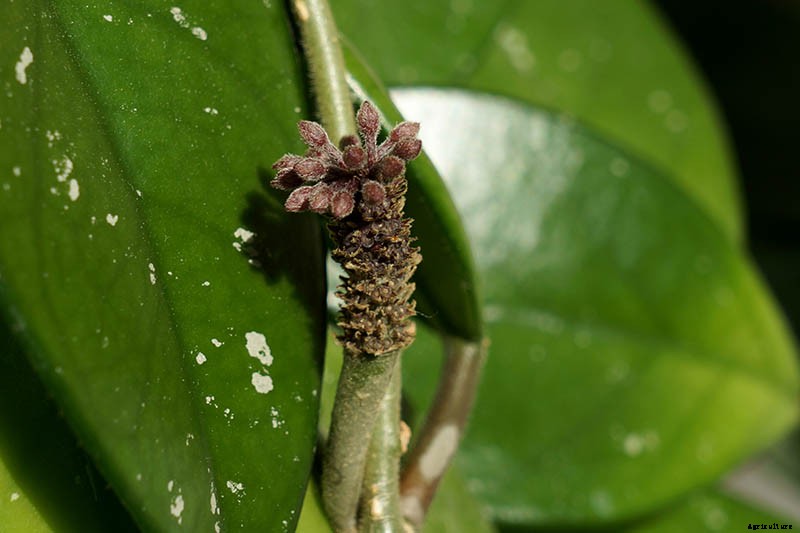
Since flowers typically emerge from the same peduncle time after time, you’ll want to take care not to prune those off.
Another factor that can affect your houseplant’s ability to bloom is your indoor climate.
If you provide your plant with a period of rest in the winter, watering it less frequently and exposing it to slightly cooler temperatures, this will also help to encourage blooming.
Finalmente, a special fertilizer with a higher phosphorus content can also help. In addition to their houseplant formula, Dr. Earth also offers a fertilizer to encourage flowering.
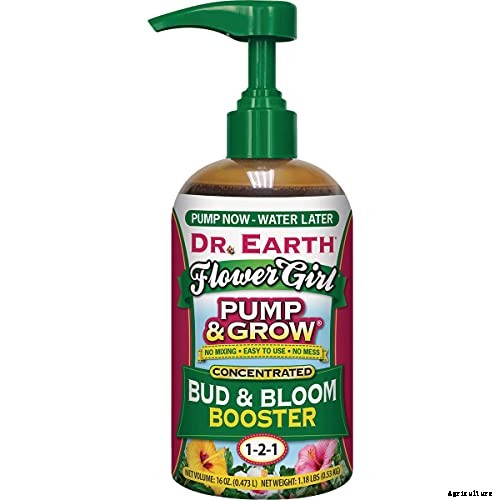
Dr. Earth Pump and Grow Bloom Booster
Their Pump and Grow Bloom Booster formula comes in a convenient 16-ounce pump, and you can find it at the Dr. Earth Store via Amazon .
But before you decide to fill your home with the sweet smell of hoya flowers, there’s one more thing you should plan for:
Hoyas produce nectar from their flowers – some species more than others – and this nectar can be somewhat messy indoors.
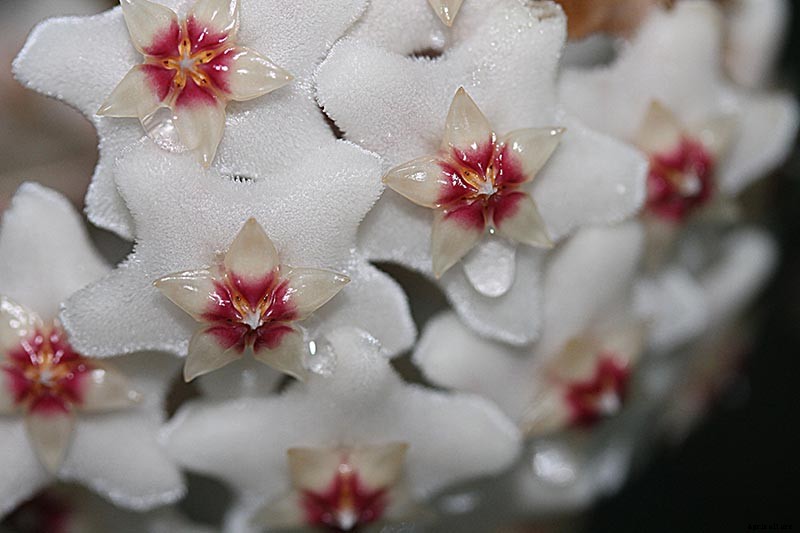
You may want to situate your houseplant accordingly to avoid having nectar drip on furniture or rugs.
Cultivars to Select
The hardest thing about growing a hoya might be deciding which species or cultivar to choose.
Here are a few options to get you started:
Carnosa
H. carnosa may be the easiest hoya to grow as a houseplant and it is one of the most popular.
Making it even more versatile, it comes in a wide range of spectacular varieties. Mas para agora, we are going to focus on the naturally occurring species.
Native to humid subtropical forests in China, Japão, Laos, and Taiwan, and adapted to low to moderate humidity, H carnosa is very well-suited to the climates in our homes.
Its leaves are dark green and sometimes flecked with white or silver. They are elliptical in shape, and quite thick, making the plant less prone to drying out.
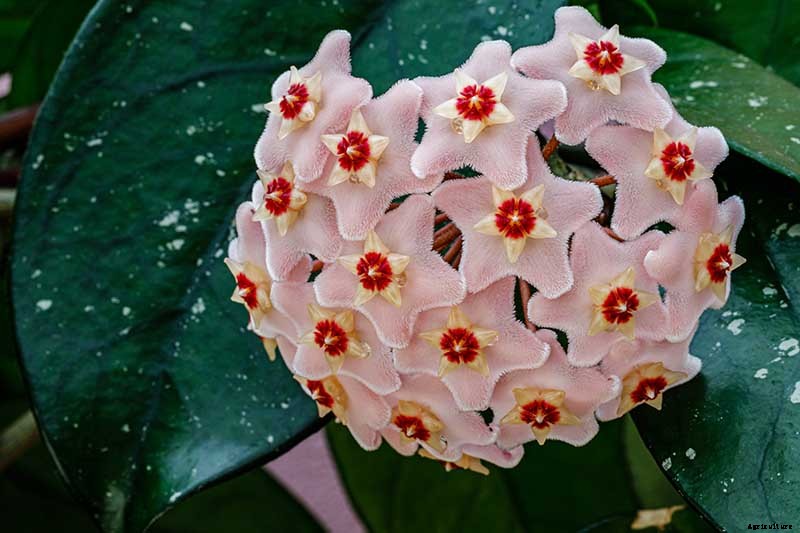
The flowers of H. carnosa are fragrant, slightly fuzzy, and white to pale pink with red centers. They will start blooming when plants are about three years old.
Carnosa vines can grow to be fifteen feet long or more – but don’t worry, it may take twenty years for them to reach that length. And if you don’t want a home full of long vines, you can always propagate cuttings for your friends and family.
This epiphyte can handle more direct sun than some of the other species but it will also be happy in bright, luz indireta.
And if you need one more reason to convince you of the merits of H. carnosa, this species received the Royal Horticultural Society’s Award of Garden Merit in 1993.
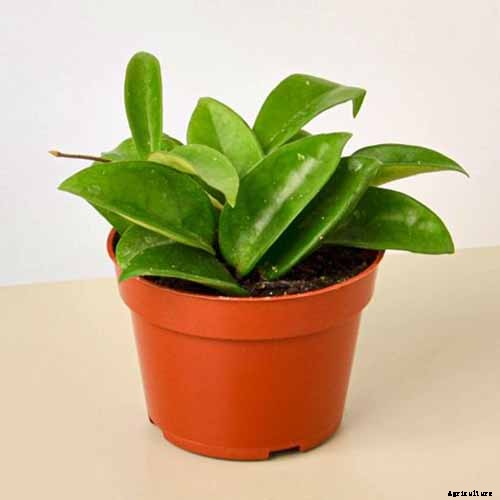
H. Carnosa Planta Viva em Vaso de 4 ”
You’ll find live plants in four-inch pots available for purchase from The House Plant Shop via Walmart .
Hindu Rope
Hindu rope is a cultivar of H. carnosa , known officially as H. carnosa ‘Compacta.’
Its green leaves are twisted and curled up on themselves, giving its long vines a thick, chunky look which is simply stunning on mature plants.
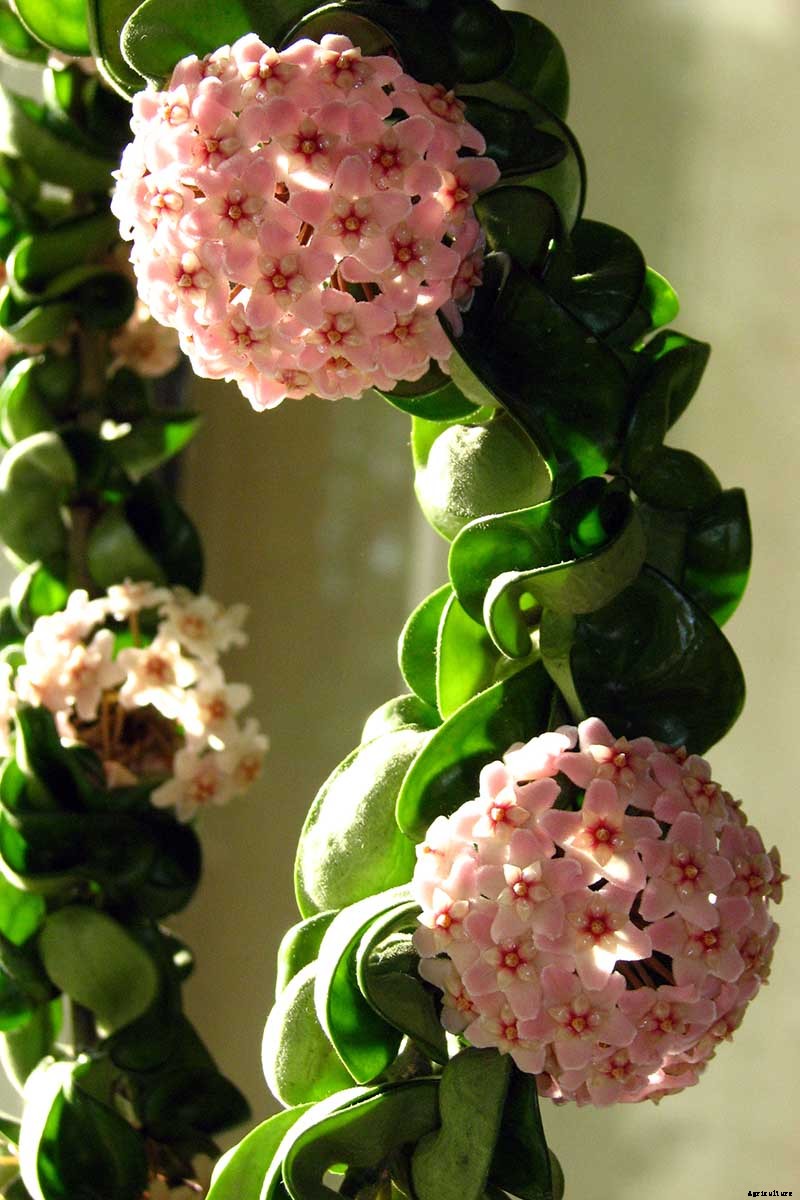
The fragrant flowers of this fascinating variety are pale pink with red centers.
Being a cultivar of H. carnosa , this houseplant has the same growing requirements.
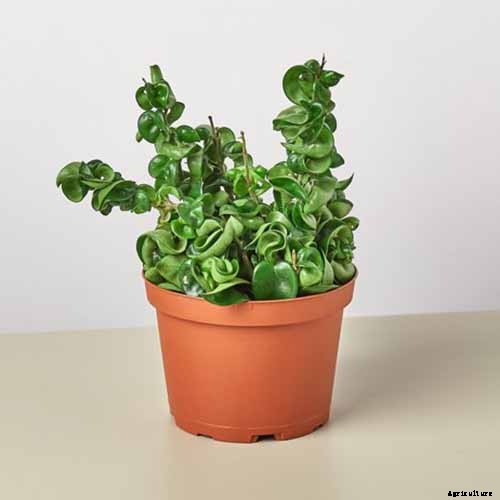
H. Carnosa Hindu Rope Live Plant in 6” Pot
You can purchase Hindu rope in a six-inch pot from the House Plant Shop via Walmart .
Kerrii
Known as “sweetheart plant, ” “waxhearts, ” or ”valentine hoya, ” H. kerrii is another of the most popular species, particularly around Valentine’s Day.
Native to Cambodia, Java, Laos, Malásia, Tailândia, e Vietnã, this species has large, heart-shaped leaves that are quite thick.
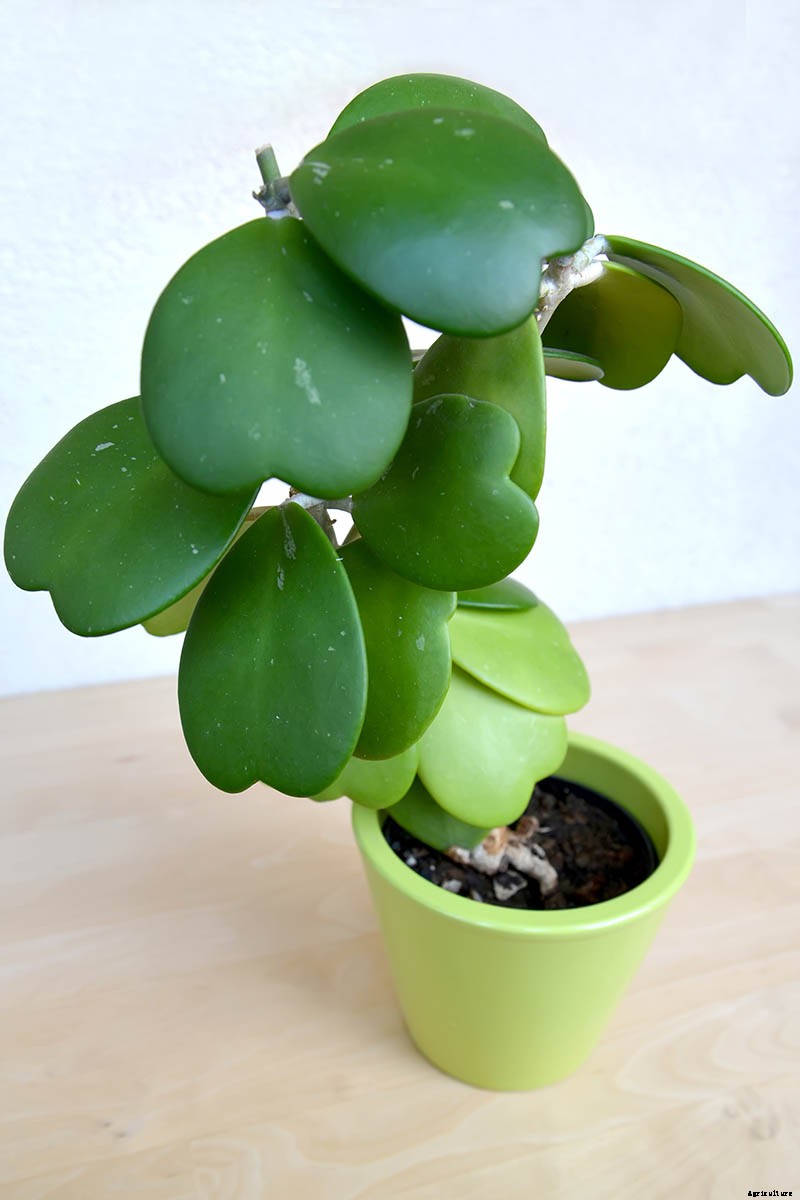
A slow grower, this epiphyte has white flowers with russet centers. It prefers moderate humidity, between 25 and 49 percent.
This type is usually priced based on the number of leaves on the plant, making mature specimens relatively expensive compared to some other types.
Learn more about growing sweetheart plants in our complete guide. ( em breve !)
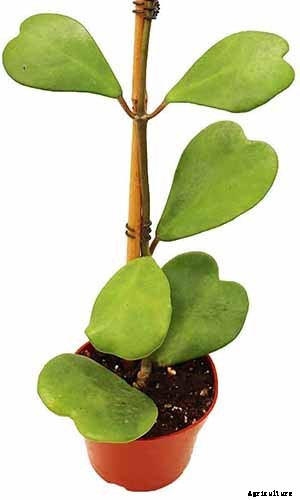
H. Kerrii Planta Viva em Vaso de 4 ”
Enquanto isso, you’ll find a live plant in a four-inch pot with four to six leaves available for purchase da Califórnia Tropicals via Amazon .
This selection reveals just the tip of the iceberg when it comes to the many different types of hoyas that you may wish to grow.
To learn more, make sure to read our article on 29 of the most fabulous hoya cultivars and species .
Managing Pests and Disease
Sometimes a houseplant enters your life and stays there without ever presenting the least sign of pest or disease problems, and that may turn out to be the case with your hoya as well. But just in case, it’s good to know what to be on the lookout for.
Inspect your plants regularly so you can catch any problems before they get out of hand.
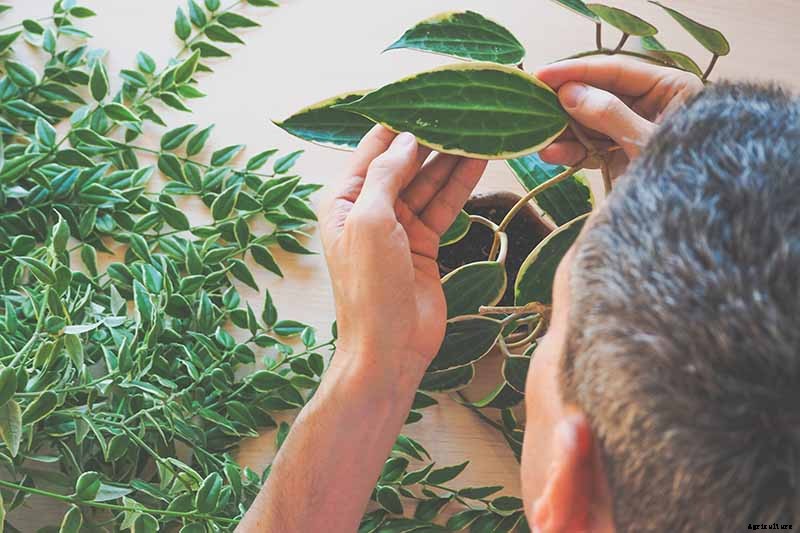
It’s also a good idea to inspect new specimens before you add them to your houseplant collection.
Even if they look healthy on initial inspection, you may want to quarantine them for a week or so before mixing them in with your other houseplants.
Here are the most common pests and problems to be on guard against.
Insetos
There are a few pests which seem to favor hoyas, and these are the ones you’re most likely to encounter:
Pulgões
Aphids don’t just colonize your rose bushes e kale crop – they can also attack your houseplants.
These tiny insects can suck nutrients from the leaves of your plants, weakening them and stunting their growth.
If you find an aphid infestation on your hoya, first try taking it outside (weather permitting) and spraying it with a jet of water from your Mangueira de jardim . Then examine your plant and pick off any remaining aphids by hand.
If you try this tactic and it doesn’t work, repeat it, but follow it up with an application of nontoxic neem oil.
To learn more about these pests, be sure to read our article on controlling aphids .
Mealybugs
What looks like bits of fluff but sucks the life out of your houseplants? Mealybugs, that’s what.
These insects, disguised as bits of hair or fur, are frequently found crowding the stems of infested houseplants.
Como pulgões, they suck nutrients from the plants they colonize, sickening the plants and preventing them from thriving.
These may be the most frequently found among pests that may infest hoya houseplants. They can be particularly hard to remove from Hindu rope hoyas because of their curled-up leaves.
If you discover an infestation, follow the same strategy as with fighting aphids. Primeiro, try removing them with a strong spray of water. If that fails, fall back to that favorite nontoxic insecticide and fungicide, neem oil.
Apply the product according to the manufacturer’s instructions. A week later, check your plant again. If you find any bugs, they should now be dead. If they’re not, pick them off, then reapply.
Em alguns casos, mealybugs can also infest the roots, so if you treat your plant and the mealybugs keep coming back, you may need to treat the roots as well.
For more information about controlling these pests, read our guide to mealybug pest control .
Escala
Related to mealybugs, scale are small insects masquerading as specks of dirt or blemishes. When scale insects have set up camp on your houseplants, you may think you’re seeing the signs of some disease.
These insects have a domed covering that enables them to blend in with the leaves. And under that cover, they are feeding on your plants.
Scale insects particularly like to hang out next to leaf veins, where they can be very hard to spot.
Neem oil is an effective nontoxic treatment for this pest as well.
If it seems like a good idea to keep a bottle of neem oil on hand in case one of these pest problems arises – and it is! – I recommend Monterey neem oil, available at Arbico Organics .
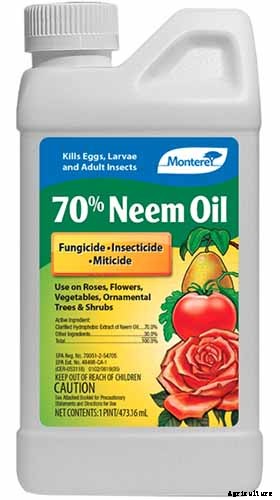
Monterey Neem Oil
To find out more about your options for fighting scale, leia nosso guia .
Doença
Most diseases and noninfectious physiological conditions that occur in hoyas can be prevented. Here’s a quick rundown of the basics:
Botrytis Blight
Are you seeing large gray patches on the leaves of your plant? Se então, botrytis blight might be to blame.
This fungal disease also affects hydrangeas , rosas, and many other garden perennials, as well as other houseplants such as African violets .
Also known as gray mold, this disease is caused by fungal species in the Botrytis genus that can colonize the foliage of your hoya when conditions are cool and damp.
In addition to causing gray spots on the foliage and stems, Botrytis blight can cause brown spots to appear on the flowers. Affected leaves can eventually turn mushy, and powdery gray spores may be visible.
Neem oil can be applied as an organic fungicide, but it’s also important to address any issues that led to the development of the disease in the first place.
Avoid misting your hoyas when conditions are cool or at night. Também, rather than watering over the foliage, pour water only onto the soil.
Finalmente, while grouping plants together can be helpful when humidity is low, make sure spacing is adequate to allow for airflow.
Edema
Edema is a physiological disorder that can occur in hoyas when they receive too much water too fast.
When the plant is unable to rid itself of excess water quickly enough , some of the plant’s cells become overfilled with liquid. This causes them to first stretch out, and then to collapse.
A plant owner may first notice bumps on the undersides of leaves, which may eventually become tan-colored and corky. These spots may eventually turn black.
Also spelled “oedema, ” this condition is not contagious, and its effects are primarily aesthetic – though with severe cases, the plant’s ability to photosynthesize can be impaired.
The only treatment for edema is prevention, so if you encounter this problem, examine your plant care routine.
You may need to get your watering on a more regular schedule, water in the morning instead of in the evening, increase air circulation, or reduce relative humidity. Making sure to use a well-draining potting medium and watering plants less during periods of cloudy, chilly weather will help as well.
Angela Madeiras, a diagnostic technician at the University of Massachusetts Amherst Extension , also recommends being careful not to overfertilize.
Affected leaves will continue to bear the marks of this condition, but if growing conditions are improved, new leaves will be unblemished.
Since only the underside of the foliage is usually affected, I recommend leaving it on the plant, at least until new leaves have grown in to replace the damaged ones.
Podridão da raiz
Root rot is a disease often caused without intention by an overly attentive plant parent. Yellow leaves may be the first sign of a problem, and in hoyas, they may start to fall off.
This disease is caused by overly soggy soil conditions which allow fungal pathogens to proliferate. Sometimes it’s caused by overwatering, sometimes by inadequate drainage, and other times allowing a plant to sit in a saucer of water is to blame.
An excess of water around your hoya’s roots will eventually deprive the poor plant of oxygen. Then the roots will rot, and the plant will die from dehydration.
Since you want your dear little hoya to have a long and healthy life, it’s important to be aware of this potential problem and go easy on the watering.
If root rot appears to be an issue with your plant, identify the problem – or problems. Then repot it into fresh, solo bem drenado, but first examine the roots and trim any that are dead or rotting.
Also be sure to take steps to prevent soggy soil in the future.
Best Uses
Hoyas can be used in a variety of different ways in the home.
Their trailing vines will look beautiful in a hanging basket. But they can also be trained to grow upwards on a trellis, stake, or any other support instead of hanging down.
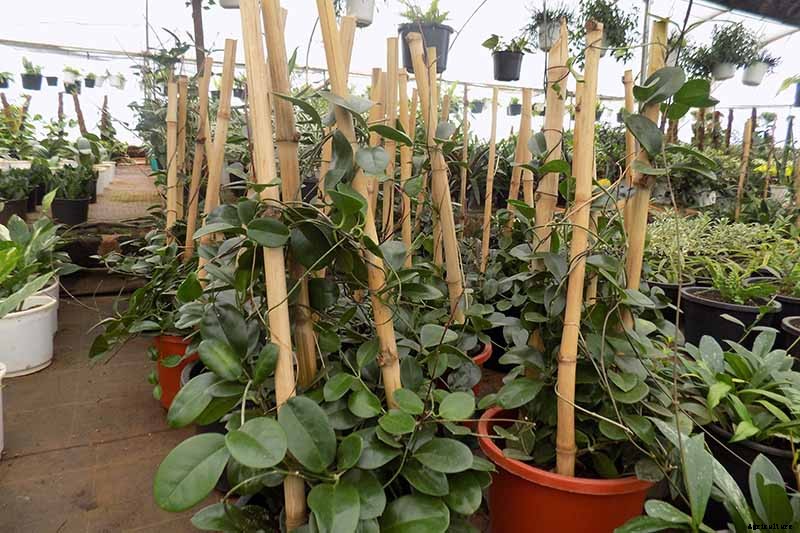
You could also train one to grow along the top of a wall, or along some other horizontal surface.
Since their water requirements are low, they can also be mounted on kokedamas.
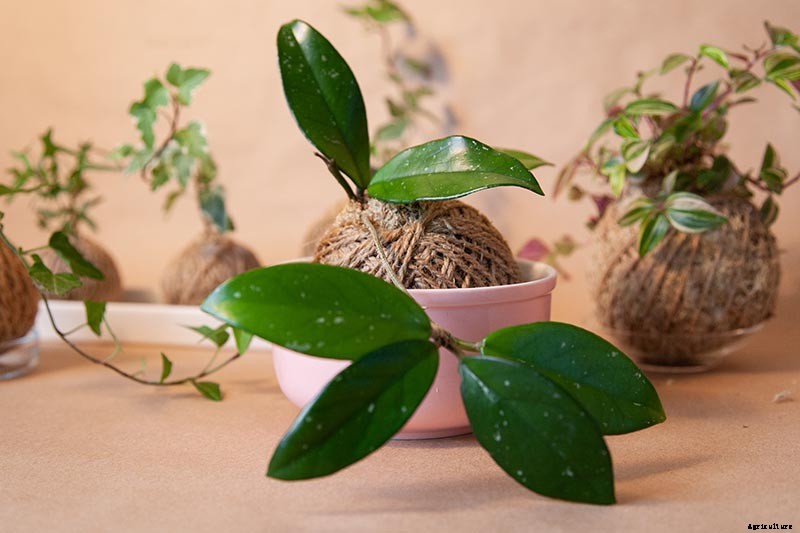
At least some hoya species are classified as nontoxic for pets , Incluindo H. kerrii , H. pubicalyx , e H. carnosa , making these better replacements for households with pets than other toxic vining houseplants such as pothos .
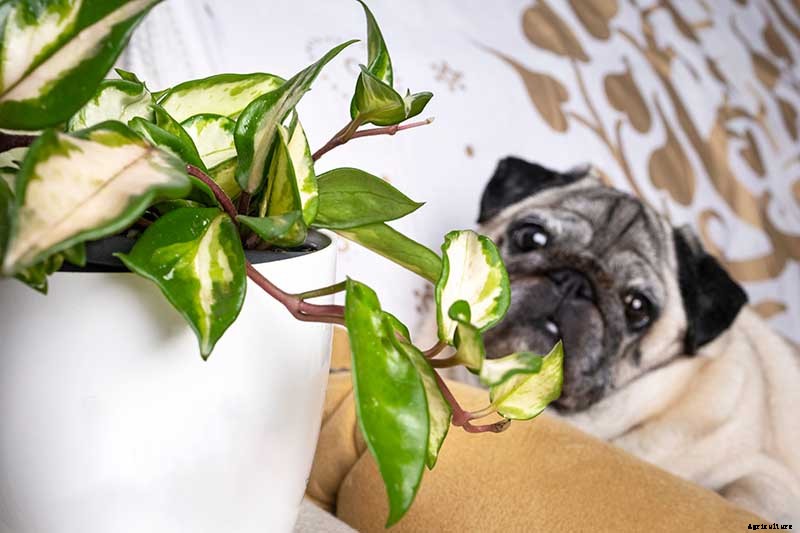
And if you’re looking for plants to improve your air quality, researchers at the University of Georgia at Athens found that H. carnosa excels at removing indoor air pollutants.
Quick Reference Growing Guide
Plant Type:Evergreen flowering vine or shrubFlower/Foliage Color:White, verde, cor de rosa, roxa, vermelho, laranja, marrom, yellow; luz verde, medium green, gray green, verde escuro, cor de rosa, vermelho, variegated, flecked, mottled Native to:Tropical and subtropical Asia and OceaniaSoil Type:Chunky succulent potting mix Hardiness (USDA Zone):9b-12, depending on speciesSoil pH:6.1-7.3 Bloom Time:Varies depending on speciesSoil Drainage:Well-draining Exposure:Bright, indirect lightCompanion Planting:Orchids, peperomia, succulents Height:1-15 feet or more, depending on speciesUses:Hanging baskets, interiorscapes, topiaries, trellises Spread:1-15 feet or more, depending on speciesOrder:Gentianales Growth Rate:Slow-moderateFamily:Apocynaceae Water Needs:Low-moderateSubfamily:Asclepiadoideae Maintenance:LowGenus:
Hoya Tolerance:HumiditySpecies:
Australis, carnosa, kerrii, latifolia, multiflora, pubicalyx, retusa Common Pests:Aphids, fungus gnats, cochonilhas, escala, shore flies, ácaros da aranha, thripsCommon Diseases:Botrytis blight, edema, podridão da raiz, stem rot
Let Your Hoya Bring You Joy
Nós vamos, amigo, the view from the hoya rabbit hole isn’t so bad, is it? Eu não sei sobre você, but I quite enjoy having my view of life slightly obstructed by a tangle of long vines.
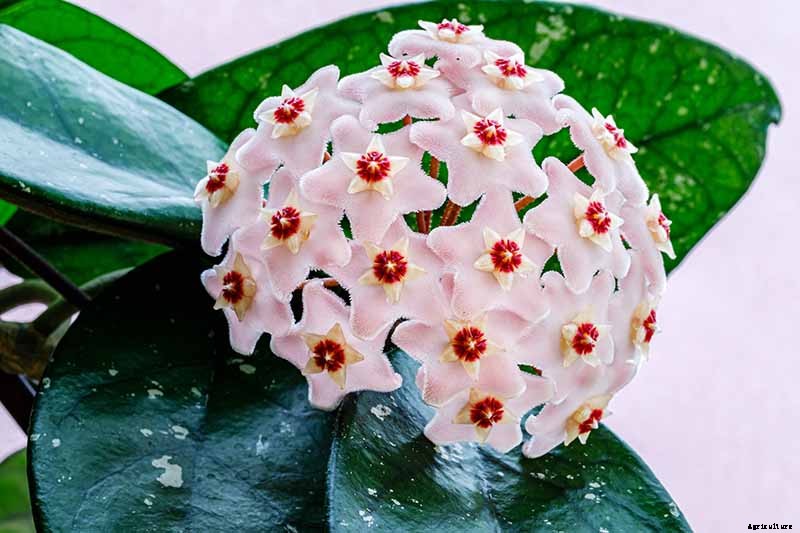
Here’s a quick recap of what we learned:keep your hoya in bright, indirect light; water infrequently; make sure the potting mix is very well draining – and start making plans for what to do with all those vines!
What has your experience been with your own hoya? Have you been lucky enough to see yours in bloom? Let us know in the comments below, and feel free to show off your pics!
And if you’re looking for some good houseplant companions for your hoya, here’s a bit more reading to give you some ideas:
- 11 Easy-Care Exotic Succulents to Grow at Home
- Orquídeas 101:Como cultivar e cuidar das orquídeas
- 23 Colorful Houseplants to Warm Up Your Home This Winter












































